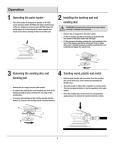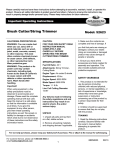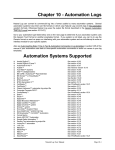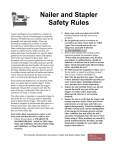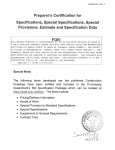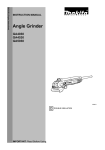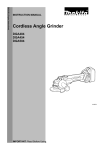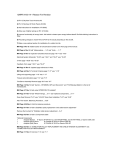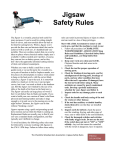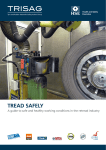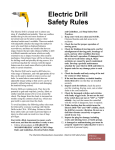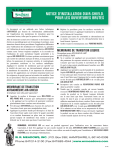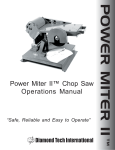Download Handheld Sander Safety - charlottewoodworkers.org
Transcript
Handheld Sander Safety Rules Handheld Sanders are available in a wide range of designs to suit the tasks that they’re intended to perform. The types of Handheld Sanders include detail sanders, palm sanders, random orbit sanders, and belt sanders. While each sander is designed for a specific purpose, when used properly, they all help reduce the effort required to shape, smooth, polish, and even buff the material or finish being used by the craftsman. Many of these sanders are electrically powered, and of those that are, the bulk have a cord that plugs into a standard electrical outlet. But there are cordless sander models that give the user more freedom of movement and can be taken to places where electrical outlets aren’t available. There are also pneumatically powered sanders that are powered by compressed air. To avoid accidents, the following safety rules must be followed by everyone working with a Handheld Sander in the CWA / JPM shop. Failure to follow these safety rules can result in personal injury or injury to others and can result in a loss of shop privileges. WARNING: When using electric tools, basic safety precautions should always be followed to reduce the risk of fire, electric shock, and personal injury. When using pneumatically powered sanders, some of the concerns related to using electric sanders are eliminated, but you need to take precautions related to working with compressed air. Safety measures that you should take while using a Handheld Sander follow. Start with a Risk Assessment to ensure a safe work area, and to verify that the sander is ready to use: 1. Follow all procedures in CHARLOTTE WOODWORKERS’ ASSOCIATION Shop Rules and Guidelines, Electrical Safety Rules and Guidelines, and Shop Safety Best Practices. 2. Read through this section completely and follow all rules regarding required protective equipment and personal safety practices before applying power to the tools you’ll be using. Details appear later in this section and address use of safety glasses, hearing protection, and steps to take to avoid safety issues related to jewelry, long hair, and clothing. 3. Keep your work area clean, properly ventilated, and well lit. Cluttered floors and benches and dark areas invite accidents. Inadequate ventilation can lead to buildup of harmful materials, especially if toxic finishes are being used in the area. 4. Ensure that all guards and covers are in place, attached properly, and working correctly. 5. Check the tool for proper operation of moving parts. 6. Check for binding of moving parts, and for misalignment of moving parts, breakage of parts, and any other condition that may affect the tool’s operation. If any damage or malfunction is found have the tool serviced before using it. Many accidents are caused by poorly maintained tools. Develop a periodic maintenance schedule for your sander and follow it. 7. Inspect tools for any damage prior to each use. 8. Check the handles and body casing of the tool for cracks or other damage. 9. If the tool has auxiliary or double handles, check them all to see that they are installed securely and are in good shape. The Charlotte Woodworkers Association | Handheld Sander Safety Rules Effective 6/23/14 DP/WJ 10. Inspect the cords on corded electric tools for defects: check the power cord for cracking, fraying, wear, cuts or other faults in the cord insulation. 11. On pneumatic sanders, inspect the pressure connector plug for defects. If the connector plug is loose or appears damaged in any way, have it serviced before using the sander. 12. Check for damaged switches. Do not use the tool if the switch does not turn it “ON” or “OFF” reliably. Any tool that cannot be controlled with the switch is dangerous; have it repaired before using it. 13. While checking that the switch turns the sander “On” and “Off” reliably, check the sander for excessive vibration. Do not use a tool that vibrates excessively or appears unsafe in any way. 14. Inspect the plug on sanders with cords for damage including cracks and missing, loose, or faulty prongs. 15. A damaged or malfunctioning part must be properly repaired or replaced prior to use to avoid risk of personal injury. 16. Do not operate power tools in explosive atmospheres, such as in the presence of flammable liquids, gases or dust. Power tools create sparks which may ignite the dust or fumes. 17. Don’t operate corded sanders in damp or wet locations. If operating the sander in a damp location is unavoidable, use a ground fault circuit interrupter (GFCI) protected supply to power the tool. Use of a GFCI protected supply reduces the risk of serious electric shock. Even with GFCI protection, AVOID RUNNING A CORDED SANDER WHILE STANDING IN WATER!!! 18. Keep the area around where you’ll be working clear of people and debris that could impair your traction or footing to avoid potential slips and falls. 19. The moving abrasive surface of a Handheld Sander can be dangerous. You can injure yourself or a bystander with these moving abrasives. Handle these tools with care. 20. Sanders have a number of moving parts, but the moving abrasive surface is usually the largest. Depending on the abrasive material 21. 22. 23. 24. used, some types, most notably belt sanders, have the potential to grab and wrap hair, jewelry, fabric or similar material around the mechanism. If the abrasive on a sander capable of this catches anything while it’s running it will either sever it immediately or wrap it up until the tool’s motor stops turning. Abrasive clamping mechanisms on certain sanders also have the potential to damage items in certain situations. Keep hands and other objects away from air vents. They cover moving parts and you could potentially injure yourself, damage the tool directly, or by blocking the airflow, could cause the tool to overheat. Dress properly when using this tool. Don’t wear loose clothing or jewelry. If you’re wearing jewelry such as necklaces, bracelets, or rings that could become caught or entangled in moving parts, remove them and store them safely. Roll up long sleeves, tuck in or remove ties, etc. Tie back, or otherwise secure, long hair. Anti-vibration gloves are designed to reduce the effects of vibration from machinery like sanders. These gloves help to absorb and dissipate the vibrational energy that would otherwise be transmitted directly to your hands, wrists, and arms. Prolonged exposure to excessive levels of vibration can cause vibration induced health conditions that start as pain and with continued exposure may develop into an injury or disease. Pain is the first health condition that is noticed and should be addressed in order to stop the injury. Vibration-induced white finger (VWF) is the most common condition among the operators of hand-held vibrating tools. Vibration can cause changes in tendons, muscles, bones and joints, and can affect the nervous system. Collectively, these effects are known as Hand-Arm Vibration Syndrome (HAVS). The symptoms of VWF are aggravated when the hands are exposed to cold. Workers affected by HAVS commonly report: attacks of whitening (blanching) of one or more fingers when exposed to cold tingling and loss of sensation in the fingers loss of light touch The Charlotte Woodworkers Association | Handheld Sander Safety Rules Effective 6/23/14 DP/WJ 25. 26. 27. 28. 29. 30. pain and cold sensations between periodic white finger attacks loss of grip strength bone cysts in fingers and wrists The development of HAVS is gradual and increases in severity over time. It may take a few months to several years for the symptoms of HAVS to become clinically noticeable. To help avoid these problems from excessive exposure to vibration take regular breaks while working with vibrating tools and wear antivibration gloves that are designed for use with such tools. If you are wearing anti-vibration gloves, DO NOT work with tools that could catch your gloved hand and pull it into the tool. For your safety you need to keep everything except the material you’re working on well clear of the abrasive and any moving parts while the machine is running. If the area you’re working in has dust collection capability, ensure that it’s connected and properly used. Use of dust collection capability can reduce dust related hazards. Most Handheld Sanders have built in connectors for attaching a vacuum hose. A shop vacuum makes an ideal dust collector for most Handheld Sanders and if the connection is available, you should use it. Keep the sander’s handles dry, clean and free from oil and grease. Never carry the sander with your finger on the power switch (throttle lever in the case of pneumatic sanders). Carrying tools with your finger on the switch or plugging in tools that have the switch held “ON” invites accidents. Remove any wrenches and adjusting keys before turning the tool “ON”. A wrench or an adjusting key that is left where it may come in contact with a moving part of the tool can cause personal injury to the operator or a bystander. There’s also the possibility that it may damage the tool, the wrench, or the adjusting key. It could also damage the material being worked on. Use safety equipment. Always wear eye protection. Non-skid safety shoes, hard hat, and hearing protection must be used when situations call for them. 31. Always wear eye protection and a dust mask, especially when sanding overhead. Sanding particles can be absorbed by your eyes and inhaled easily and may cause health complications. 32. Safety glasses (ANSI Z87.1) and (CAN/CSA Z94.3) with side shields or a face shield must be worn. Everyday eyeglasses are only made of impact resistant glass, they aren’t safety glasses. If you’re not wearing actual safety glasses, wearing safety goggles over your regular glasses can provide the protection you need. If sanding overhead consider how well your eye protection will keep dust that’s “floating” in the air out of your eyes. There are powered respirators that combine a face shields with a filter that pulls in the air coming into the respirator, filters it, and blows it into the space between the wearer’s face and the respirator, creating a positive pressure inside the respirator that keeps fine dust out of the air you breathe while using the respirator. The TREND Airshield is an example of one of these. There are others. 33. Use the appropriate dust mask or respirator in dusty work conditions. All Sanders create dust and protection from that dust is important to your long term health. 34. Hearing protection should be worn. 35. Give the work your undivided attention. Operational Safety Rules: Handheld Sander Safety – You Play a Key Role 36. Approach your work in the Shop & while using the Handheld Sander with a safe attitude! 37. Read the manual of operating/safety instructions (User Manual) that came with the Handheld Sander you plan to use. If you can’t find this manual and if the Shop Foreman can’t help you find it, someone can download a copy of the manual from the internet. This manual should tell you where the various switches and controls for the Handheld Sander are and how they’re supposed to work. 38. If you don’t know how to use the model of sander properly for the work you plan to do, The Charlotte Woodworkers Association | Handheld Sander Safety Rules Effective 6/23/14 DP/WJ 39. 40. 41. 42. 43. 44. 45. get instruction on how to use it correctly for what you want to do BEFORE beginning. Keep bystanders, children, and visitors away from the work area while operating a power tool. Having anybody not involved in the sanding operation nearby can create distractions that can cause you to lose control which can result in poor quality results or with some of the larger and more power Handheld Sanders could result in serious personal injury. Stay alert, watch what you are doing and use common sense when operating a power tool. Do not use tools while tired or under the influence of drugs, alcohol, or medication. A moment of inattention while operating a power tool may result in serious personal injury. Use Handheld Sanders, their accessories, and associated abrasive materials in accordance with the manufacturer’s instructions for that item and in the manner intended for the particular type and model of tool that you’re using, taking into account the working conditions and the work to be performed. Use of any tool, especially a power tool, for operations different from those it’s intended for could result in a hazardous situation. Keep the sander’s air vents clear to maintain adequate airflow through the tool. Proper ventilation helps keep the sander from overheating while in use. Use the proper tools that are the correct size when making adjustments or changing abrasives or accessories. Using tools that don’t fit properly can damage the parts that these tools engage when performing these tasks (adjusting screws can be damaged) wrenches can slip on a nut if they don’t fit properly and may damage the nut or you could be injured when the your hand strikes the sander unexpectedly. Keep power cords away from heat, water and oil. Though it should be obvious, when using a Handheld Sander, make sure you don’t contact the power cord with the moving abrasive material or any other moving part of the sander that could potentially damage the cord. Always make sure that the switch is “OFF” before plugging the Handheld Sander in or installing its battery pack. You’ll need to verify that nothing is depressing the power switch, including your finger(s), and that the switch isn’t locked “ON”. A similar precaution must be taken with pneumatically powered tools. To avoid accidental starting of a pneumatically powered tool - ensure tool is in “off” position before applying air pressure, avoid throttle when carrying the tool, and release the throttle when loss of air occurs. Whether using an electrically powered tool or a pneumatically powered tool, accidental start-ups have the potential to cause injury. 46. Carrying a sander with your finger on the switch or throttle lever invites accidents if the tool is connected to its power source or is a cordless model. While it may seem that the sander presents little danger, some sanders, especially with course abrasives, can cause serious injury if they contact a part of your body while the tool is running. 47. Never unplug tools by pulling on the power cord. When unplugging equipment pull on the plug, not on the cord. 48. Hold electrically powered sanders only by the handles or another insulated gripping surface when sanding in areas that may contain “live” wires or where the sander’s operation may cut its own power cord. On most handheld power tools, electrically powered sanders included, contact with a "live" wire may make exposed metal parts of the tool "live", which can shock the operator. If possible, do not sand in blind areas where electrical wiring may exist. If this situation is unavoidable, disconnect all fuses or circuit breakers feeding that part of the worksite before proceeding and ensure that the cord is held securely out the path of the sander’s moving abrasive surface. Pneumatically Powered Sanders Specific safety precautions that must be taken for pneumatically powered sanders include:i 49. Always install, operate, inspect and maintain pneumatic sanders in accordance with the guidelines set forth in the safety and use section of the tool’s manual. The Charlotte Woodworkers Association | Handheld Sander Safety Rules Effective 6/23/14 DP/WJ 50. Always use clean, dry air at the proper pressure as set forth in the safety and use section of the tool’s manual. Never exceed the specified maximum air pressure at the inlet. Higher pressure may result in hazardous situations including excessive speed, rupture, or incorrect output torque or force. 51. Be sure all hoses and fittings are the correct size and are tightly secured. 52. Ensure an accessible emergency shut off valve has been installed in the air supply line, and make others aware of its location. 53. Install a properly sized Safety Air Fuse upstream of hose and use an anti-whip device across any hose coupling without internal shutoff, to prevent hose whipping if a hose fails or coupling disconnects. 54. Do not use damaged, frayed or deteriorated air hoses and fittings. 55. Keep clear of whipping air hoses. Shut off the compressed air before approaching a whipping hose. 56. Always turn off the air supply, bleed the air pressure and disconnect the air supply hose before installing, removing or adjusting any accessory on this tool, or before performing any maintenance on this tool or any accessory. 57. Do not lubricate pneumatic tools with flammable or volatile liquids such as kerosene, diesel or jet fuel. Use only recommended lubricants. 58. Use only proper cleaning solvents to clean parts. Use only cleaning solvents which meet current safety and health standards. Use cleaning solvents in a well ventilated area. 59. Do not remove any labels. Replace any damaged label. 60. This tool is not designed for working in explosive environments, including those caused by fumes & dust, or near flammable materials. 61. In general, air powered tools are not insulated against electric shock. Even though pneumatic sanders, buffers, and polishers are not electrically powered, they can still be conductive. Avoid bringing these tools into contact with “live” electrical power sources. 62. Do not carry or drag the tool by the air hose. 63. Use only sanding, polishing and buffing accessories with these tools. Do not use any grinding wheel, wire wheel, burr or cutoff wheel with these unguarded tools. 64. Do not use any sanding, polishing and buffing accessories whose maximum operating speed is less than the maximum rated speed of the tool. Using the Handheld Sander 65. Never abuse the power cord on corded tools. 66. Never use the cord to carry the sander. 67. Maintain tools with care. Keep the tools clean and in good repair. Properly maintained tools will be safer and yield better results. 68. Turn the sander “OFF” and let it come to a complete stop, before disconnecting power (electric or air) or removing the battery pack. 69. Disconnect the power source before installing or changing abrasives, making any adjustments, performing maintenance, or installing or changing accessories. If the sander is electrically powered disconnect power by unplugging it or removing the battery pack. If using a pneumatic sander, shut off the air supply and bleed the pressure from the air hose supplying the sander, or disconnect the air hose. Such preventive safety measures reduce the risk of starting the tool accidentally. 70. Do not run the sander while carrying it at your side. Accidental contact with the moving abrasive or other accessory could snag your clothing, pulling the abrasive or other accessory into your body. 71. Never lay the Handheld Sander down until the sander and all attached accessories have come to a complete stop. An accessory that is still moving may grab the surface and pull the tool out of your control. 72. Any alteration or modification of the sander is considered misuse and may result in a dangerous condition. 73. Your material should be clean, free of dirt and other debris, and not have sharp metal fasteners (nails, screws, staples, etc.) of any kind protruding in the area where you’ll be sanding. 74. Allow the sander to come up to full speed before the abrasive contacts the material to be sanded. On a typical model this only takes a second or so, but you still need to allow that The Charlotte Woodworkers Association | Handheld Sander Safety Rules Effective 6/23/14 DP/WJ 75. 76. 77. 78. 79. 80. 81. 82. 83. short time for the abrasive media to get up to full speed. Do not sand a workpiece that is too small to be safely supported and held securely especially when sanding with rotating sanders or belt sanders that could grab and throw the workpiece. If you’re working with pieces of stock too small to sand safely, use a different sander or consider hand sanding. If you use the sander for sanding metal surfaces, watch out for flying sparks. Hold the tool so that sparks fly away from you and other people or flammable materials. Do not touch the workpiece immediately after operation; it may be extremely hot and could burn your skin. When taking a break or when finished using the Handheld Sander for the day, unplug the sander, remove the battery pack, or disconnect the air supply and store the tool and all of its accessories properly, out of the reach of children and other untrained persons. Tools are dangerous in the hands of untrained users. Before storing the sander for the day, clean it to remove sawdust and debris so that it will be ready for the next person to use. Coil the cord neatly (if it’s a corded electric model), and then store the tool properly. Make certain that all locking adjustments are properly locked before plugging the sander in, connecting it to the air supply, or installing its battery pack. Loose adjustments can slip and cause loss of control. A general best practice is to lock each adjustment properly before moving on to the next task as you make the sander ready to use. NOTE: properly tightened means just that, follow the instructions in the user manual or other reliable reference. These parts can be over tightened too, so be sure you know how tight “properly” tightened is. Keep a firm grip on the sander to maintain control and get the best possible results. Firm means comfortably firm, not a knuckle whitening clenched grip. Keep both hands away from the area where the sandpaper is moving. Do not overreach. Keep proper footing and balance at all times. Proper footing and 84. 85. 86. 87. 88. 89. 90. 91. 92. balance enables better control of the tool in unexpected situations. Release the power switch (throttle lever on pneumatic sanders) immediately if the abrasive binds or the sander stalls. The sander will do its job better and more safely at the rate that it was designed for. Do not apply excess pressure to the sander to try to force it to remove material more quickly. If the sander seems to be bogging down or you’re having other problems with sander performance, contact the Shop Foreman who can help you determine what’s going wrong. If your sander is equipped with a dust bag or canister, empty it frequently during use, after completion of sanding, and before storing the sander. Be extremely careful when disposing of dust, materials in fine particle form may be explosive. Do not throw sanding dust on an open fire. Combustion of mixtures of varnishes, lacquers, polyurethane, oil or water with dust particles can occur if there is a static discharge or spark from another source or if there is excessive heat. Do not use accessories that require liquid coolants with electric sanders. Using water or other liquid coolants may result in electrocution or shock. Do not wet sand with electrically powered sanders. Liquids entering the motor housing of electrically powered sanders present an electrical shock hazard. If the sander you’re using has a trigger lock, never leave the trigger locked “ON”. Before plugging the tool in, check that the trigger lock is “OFF”. Accidental start-ups can cause injury. Be aware of the location and setting of the Switch "Lock-ON" Button. If the switch is locked "ON", be ready for emergency situations to switch it "OFF". It’s common to accomplish this by first pulling the trigger then immediately releasing it without pressing the "Lock-ON" button. Read the user manual for your model of sander to ensure that you know how this feature works on your sander. DO NOT SAND Chemically Pressure Treated Lumber, Paint that may be Lead Based, or any other materials that may contain carcinogens in the CWA/JPM shared The Charlotte Woodworkers Association | Handheld Sander Safety Rules Effective 6/23/14 DP/WJ shop area. Sanding materials like these requires a suitable breathing respirator, and protective clothing must be worn by all persons entering the work area. Such work areas should be sealed by plastic sheeting and persons not protected should be kept out until work area is thoroughly cleaned. Our shared shop situation makes such safety precautions impractical during normal times of operation; therefore we require that members NOT sand these sorts of materials in the shared shop space. 93. Do not use sandpaper intended for larger sanding pads on any sander. If cutting sandpaper for use on sander that accepts sandpaper that is cut to size, cut it to the specified size and never larger. Larger sandpaper will extend beyond the sanding pad causing snagging, tearing of the paper or kickback. Extra paper extending beyond the sanding pad can also cause serious lacerations. Non-Rotary Sanders and Polishers (Includes Sanders driven in an Orbital or Reciprocating Motion with Pads that Don’t Rotate) Orbital sanders move the abrasive media in a small orbital stroke and do not rotate the sanding pad. With orbital sanders it is common to be able to sand reliably right up to the edge of the material being sanded even in corners and into tight spaces if using an orbital detail sander. Sanders with a reciprocating motion are commonly straight line sanders that are commonly used for leveling flat surfaces. They are more common in the auto body repair industry, but can be used to level and polish surfaces such as tabletops if they are available. These sanders are commonly pneumatic sanders and use pistons to achieve the straight line motion. Rules for safe use of these sanders apply to all other types of sanders as well and so are not itemized separately in this section. Random Orbital Sanders Random Orbital Sanders have an eccentric motion that creates small swirling movement of the abrasive media while pad rotation is caused by centripetal force that results from the crankshaft offset rather than being directly driven as is the case with Rotary Orbital Sanders. The random orbit sander is intended to function as a sander or polisher. 95. Random orbit sanders should NOT be used for operations such as grinding, wire brushing or powering a cut-off wheel or blade. Performing operations for which this power tool was not designed may create a hazard and can result in personal injury. 96. Check the backing pad carefully for cracks, damage or deformity before operation. Replace a cracked, damaged or deformed pad immediately. 97. The rated speed of any accessory must be at least equal to the maximum speed marked on the power tool. Accessories running faster than their rated speed can break up and fly apart, which can lead to serious personal injury. 98. The outside diameter and the thickness of all accessories must be within the capacity rating of your power tool. Incorrectly sized accessories cannot be adequately guarded or controlled. 99. Keep the cord away from the spinning pad and sandpaper when using corded electric random orbit sanders. If the cord contacts the pad or sandpaper it can become entangled or could potentially be cut, exposing live electrical wiring. 100. Be aware that the moving abrasive is sharp and contacting it can result in personal injury. 101. The arbor size of wheels, flanges, backing pads or any other accessory must properly fit the spindle of the power tool they attach to. Accessories with arbor holes that do not match the mounting hardware of the power tool will run out of balance, vibrate excessively and may cause loss of control. 102. Do not use excessively oversized sanding disc paper. Follow the manufacturer’s recommendations when selecting sanding paper. Larger sanding discs which extend beyond the sanding pad present a laceration hazard and may cause snagging, tearing of the disc or kickback. 94. The Charlotte Woodworkers Association | Handheld Sander Safety Rules Effective 6/23/14 DP/WJ 103. When using one of these sanders for polishing, do not allow any loose portion of the polishing bonnet or its attachment strings to spin freely. Tuck away or trim any loose attachment strings. Loose and spinning attachment strings can entangle your fingers or snag on the workpiece. 106. Disc sanders should be accorded the same safety precautions due random orbit and rotary orbital sanders. They simply don’t offer the finer scratch pattern that the sanders with an orbital action component do. Belt Sanders Rotary Orbital Sanders A Rotary Orbital Sander’s sanding pad is directly driven to rotate and simultaneously has an eccentric/orbital motion. This type of sander it made more aggressive due the forced rotation of the sanding pad, and differs from the Random Orbital Sander’s motion whose pad rotation is caused by centripetal force rather than being driven directly. Rotary Orbital motion is often available as a mode in dual mode sanders that use abrasive discs. Models that use this sanding mode include the Festool Rotex Dual Mode Sander. The Rotary Orbital Sanding mode is more aggressive than the random orbital sanding mode because the rotation is power driven. This makes it possible to remove material more rapidly, but also increases the possibility of kick-back from the disc rotating under power. For more information on kickback and how to control it, see the section on “CAUSES AND OPERATOR PREVENTION OF KICKBACK” later in this document. 105. Other than the items immediately above, all precautions listed for Random Orbit Sanders apply to Rotary Orbital Sanders and dual mode sanders in either random orbit or rotary orbital mode. Read all specific instructions for Random Orbit Sanders before using a Rotary Orbital Sander. 104. Disc Sanders Disc Sanders rotate without the orbital motion that is part of the sanding action on sanders such as random orbital sanders and rotary orbital sanders. These sanders are more aggressive with a greater potential for damaging the workpiece if mishandled and more opportunity to injury the operator than some of the sanders types whose discs don’t rotate under direct power. Belt sanders drive an abrasive belt to remove material. They usually don’t have the added orbital movement of the abrasive media that some of the other types of sanders incorporate. The moving belt is supported below and against a platen that helps it maintain a flat surface that allows sanding flat material reliably. 107. Keep your fingers and clothing away from the belt. They could get cut or wedged between the belt and the pulley and/or motor housing. 108. Properly adjust tracking of belt to avoid it overhanging the housing. A running belt overhanging its housing can cause severe lacerations. 109. Keep the cord to the side, away from the pulleys. Otherwise, the cord could be pulled into belt housing and become entangled with the pulleys. 110. Clamp or secure the workpiece when sanding. Clamping the workpiece prevents it from being ejected from under the sander and leaves both hands free to control the sander. Changing Abrasives 111. Turn the sander “OFF”, and once the sander and abrasive come to a complete stop, unplug it. 112. As you’ve read, there are a number of different types of Handheld Sanders, and each model may differ from models that are basically similar, so READ THE USER’S MANUAL to learn how the abrasive material is removed and replaced in the model you’re using. 113. Most non-rotary sanders clamp the sandpaper between a pair of clamps located at opposite ends of the sanding pad, but some may use pressure sensitive adhesive The Charlotte Woodworkers Association | Handheld Sander Safety Rules Effective 6/23/14 DP/WJ (peel-n-stick) or hook and loop to attach the sandpaper. 114. Disc Sanders generally use either a pressure sensitive sanding disk or a hook and loop disc. 115. Belt Sanders use sanding belts that usually changed by releasing tension between the drive and idler rollers then reapplying the tension once the old belt is removed and the new one is installed. loose or cracked wires. If the sander or an accessory is dropped, inspect it carefully for damage or in the case of a dropped accessory that is normally disposable, install an undamaged accessory. After inspecting and installing an accessory, position yourself and all bystanders away from the plane of the rotating accessory and run the power tool at maximum no-load speed for one minute. Damaged accessories will normally break apart during this test time. Dust Collection Support and Secure Workpieces for Safety 116. Handheld Sanders are typically designed to attach to a dust collector (or shop vacuum) though some come with a dust bag or canister to capture the dust the tool generates. 117. Handheld Sanders designed to collect dust that can be used with sandpaper that isn’t pre-cut and punched for dust collection usually come with a device called a “punch plate”. Punch plates allow the user to punch holes for dust collection in regular sandpaper so that dust from sanding can be pulled into the dust collector or dust canister. The punch plate is a critical accessory for the sander and you should always care for it well and store it carefully where it will be easy to find. Accessories – Sanders have two common accessories, punch plates and vacuum adapters, but some models have others. 118. Use only accessories that are recommended by the manufacturer for your model of sander or that are approved for use with your specific sander model. Accessories that may be suitable for one model of a tool may become hazardous when used on another model that they weren’t designed for. 119. Install accessories properly. Follow the manufacturer’s instructions on how to properly install and secure accessories. 120. Do not use a damaged accessory. Before each use inspect all accessories such as abrasive wheels for chips and cracks, backing pads for cracks, tears or excess wear. If your model of sander explicitly supports the use of wire brushes (most don’t), inspect the wire brush for 121. Use clamps or another practical approach to secure and support the workpiece to a stable platform. NEVER support stock for sanding by hand or with any part of your body (or an assistant’s body). Holding the work by hand or against your body is unstable and may lead to loss of control which could lead to injury or damage to the material you’re working on. Properly securing the workpiece prevents it from being ejected from under the sander and leaves both hands free to control the tool. If the item being sanded is free-standing, like the top of a kitchen table or a chest of drawers that’s already assembled, the item’s structure may provide adequate and secure support if it’s resting securely on the floor. 122. Ensure that the workpiece is properly secured before starting to sand or polish. Properly supported and secured stock is safer to work with and will make achieving the best quality results easier. 123. Make sure all supports, clamps and holding devices are clear of the area that needs to be worked on before continuing. 124. Keep the workpiece securely supported until you’ve finished all your sanding and/or polishing on that workpiece in that position. CAUSES AND OPERATOR PREVENTION OF KICKBACK: Causes of Kickback Kickback is a sudden reaction to a pinched or snagged rotating wheel, backing pad, or any other The Charlotte Woodworkers Association | Handheld Sander Safety Rules Effective 6/23/14 DP/WJ rotating sander accessory, causing an uncontrolled tool to move forcefully and without warning away from the direction of sanding pad movement. Pinching or snagging causes rapid stalling of the rotation which in turn causes an uncontrolled power tool to be forced in the direction opposite of the direction of normal rotation at the point where the stalling force occurs. The wheel that kicks back may jump in any direction, depending on the point in the rotation where the wheel’s normal movement is interrupted. This can be at any angle either toward or away from the operator, depending on direction of the wheel’s movement when kickback occurs. This can cause damage to the sanded surface or can result in injury to the operator or an assistant if the tool or abrasive contacts someone before it comes to a complete stop. Reducing Kickback When Using the Sander Kickback is the result of power tool misuse and/or incorrect operating procedures or conditions and can be avoided by taking proper precautions as outlined below. a) Maintain a firm grip on the power tool and position your body and arms to allow you to resist kickback forces. Always use the auxiliary handle, if provided, for maximum control over kickback and torque reaction during start-up. The operator can control torque reactions or kickback forces, if proper precautions are taken. b) Never place either hand near a sander’s rotating sanding disc or any other sander accessory that rotates while the sander is running. If kickback occurs at some points in the rotation, the sanding disc or other rotating accessory may travel across your hand or arm when kickback occurs. Remember, you can never tell exactly where a sander will move when kickback occurs. The direction the sander travels when kickback happens depends on where on the circumference of the rotating sanding disc or accessory the stall occurs. c) Do not position your body in the area where the power tool is likely to move if kickback occurs. Kickback will propel the tool in the direction opposite to the wheel’s movement at the point of snagging. d) Use special care when working in corners, around sharp edges, etc. Avoid bouncing and snagging the accessory. Corners, sharp edges or bouncing have a tendency to snag the rotating accessory and cause loss of control or kickback. e) Do not attach a saw chain woodcarving blade or toothed saw blade to any sander. Such blades create frequent kickback and loss of control. These types of blades were designed for use on tools like angle grinders, biscuit joiners, and trim saws. DO NOT attempt to use them on a sander. Hazardous Materials 125. Some dust created by power sanding, sawing, and grinding, drilling, and other construction activities contains chemicals known to cause cancer, birth defects or other reproductive harm. Some examples of these chemicals are: • Lead from lead-based paints • Crystalline silica from bricks, cement and other masonry materials • Arsenic and chromium from chemically treated lumber Your risk from these exposures varies, depending on how often you do this type of work. To reduce your exposure to these chemicals: work in a well ventilated area, and work with approved safety equipment, such as those dust masks that are specially designed to filter out microscopic particles. The Charlotte Woodworkers Association | Handheld Sander Safety Rules Effective 6/23/14 DP/WJ Maintenance 1. Maintain tools with care. Keep tools in good condition and clean for safer and better performance. Follow the instructions in the User Manual for maintenance and changing accessories. 2. Keep all controls dry, clean and free from oil and grease. 3. Keep ventilation slots clear. Use care not to get debris into the interior of the tool when cleaning it. 4. Clean the exterior of the tool with a soft cloth. Don’t use anything on the cloth unless specifically recommended in the User Manual. See the warning regarding solvents in the section under “Service”. Safety Information 45735685 Edition 1 (45735685_ed1) June 2008 © 2008 MATCO TOOLS Service 1. Tool service must be performed only by qualified repair personnel. Service or maintenance performed by unqualified personnel could result in a risk of injury. For example, internal wires may be misplaced or pinched. If a tool belonging to CWA or our host organization needs maintenance, contact the Shop Foreman. If the tool is still under warranty, they will make arrangements for the service to be done under the warranty. If the manufacturer’s warranty has expired, they will ensure that the tool is repaired by properly qualified repair personnel. 2. When servicing a tool, use only approved replacement parts. Follow instructions in the Maintenance section of the manual applicable to that make and model of tool. Use of unauthorized parts or failure to follow the correct maintenance instructions may create a risk of electric shock or injury. 3. Certain cleaning agents such as gasoline, carbon tetrachloride, ammonia, etc. may damage plastic parts. Before using chemical cleaning agents on a tool, check the manual for that make and model of tool for approved cleansers and cleaning procedures. i Information on safe use of pneumatic sanders is adapted from Rotary Air Sander, Polisher or Buffer - Product The Charlotte Woodworkers Association | Handheld Sander Safety Rules Effective 6/23/14 DP/WJ











